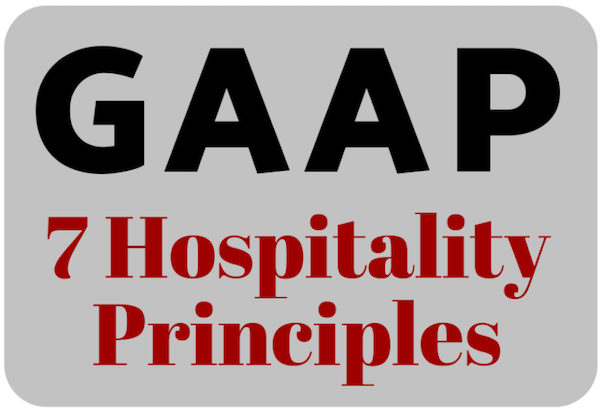
By David Lund
Accounting was a trade that had a global language much like carpentry or plumbing. There were universal rules that applied and these principles were exactly the same in the hotel business. That was good news. Accounting principles are universal. The way in which accounting is done throughout the world is a direct by-product of these principles:
“Accounting principles are the rules and guidelines that companies must follow when reporting financial data. The common set of U.S. accounting principles is the Generally Accepted Accounting Principles (GAAP).”
These principles are the very foundation that the business world relies on to ensure the relevance and meaning of financial information. These principles existed before the advent of the accounting profession; much like gravity had always been there for the plumber. In this chapter, I reviewed a few basic processes, the ones most relative to the hotel world.
I teach these to my non-financial leaders as business principles; I purposely leaver out the accounting connotation.
The why for what we did.
They connect the everyday activities to the business of hotels so leaders can understand why we do what we do a certain way. This is powerful stuff. It’s no longer me making up work for you. There is a rhyme and a reason for everything we do. For many non-financial leaders, this is the key to dropping their resistance to getting on board with their numbers.
The Matching Principle
The number one principle that the entire hotel accrual accounting system is built on is the “matching principle.” This principle dictates matching revenues with expenses to determine profitability within the accounting period. It also means the exchange of money and its timing has no relevance to the financial (P&L) results.
The accrual accounting system is used by most hotels; only very small inns and bed and breakfasts (B&Bs) used the cash system of accounting. The cash system calls for revenues and expenses to be realized at the same time the money is exchanged. Hotels use the matching principle and accrual accounting for a more accurate picture of the profit or loss.
The hotel business is a retail business and every day the property management system is closed off, as is the point of sale systems and, in turn, sales are known. Collecting the cash for sales is irrelevant to recording the volume of revenue. Knowing revenues in the month for the month is the starting point. Now close the books and determine the costs for the same period. This is where things get a little tricky. The monthly calendar was not designed to handle weekly or bi-weekly payroll, so we always need to accrue for the payroll missing until the end of the month and also reverse the previous month’s accrual. With expenses, be sure to accrue for items that were delivered or provided, but no invoice was received.
The entire process around the matching principle is designed to get an accurate picture of what happened with revenues and expenses in a specific month or year.
This principle is the juice that makes the month-end closing process fun. For instance, did everything get done in the month; was the month close a clean one? It could also be the area where some people can turn a blind eye to what should be included (accrued) with an eye only to improving results. This is a serious offense and is not an error. Perpetrating these actions can lead to a lot of trouble.
The Materiality Principle
Another very important principle, especially for hotels, is the materiality principle. What is material to financial reporting and how does that dictate how it is treated? What got “represented” on balance sheets via the processes? What was omitted and why?
One hundred percent of what was consumed, payroll and expenses were included on the profit and loss statement. It got tricky with the balance sheet and how to either directly expense what was bought or put it into an inventory or pre-paid account.
The materiality principle dictates the treatment. In the hotel world, the terms tequila, tenderloin and toilet paper helped to show the distinction. For this example, the tequila and tenderloin were material items in the business, but toilet paper was not. That was not to say the toilet paper was not important. When it was needed, it was important. It was just not material and therefore the accounting treatment was different. Tequila and tenderloin were sold, while toilet paper was used.
Tequila and tenderloin were assets that can readily turn into profits. These items were somewhat expensive and required storage under lock and key. Therefore, the material accounting and inventory of these items represented the remaining value on a balance sheet at month end. With the toilet paper, it was recorded as an expense as it was purchased, skipping the balance sheet. It did not count at month end but was treated as consumed when bought.
Many, many items are treated the same as toilet paper in the hotel business simply because these were not deemed as material.
The Business Entity Principle
This principle dictates that—unless a sole proprietor—the assets of the business and any rights to use these assets are separate and distinct.
For example, if Henry Ford was still alive and CEO of the Ford Motor Company, the cars sitting on the factory’s assembly line belonged to the shareholders of the Ford Motor Company and not Henry Ford.
The assets and liabilities of the company are separate and maintained distinctly from its executives, principles and employees. This principle also means that only the transactions directly pertaining to the business are entered into the company’s books. We hear in the public from time to time how executives use certain company assets like jets to transport family on a holiday. The company assets are not assets belonging to the executives and, therefore, should not be treated as such. This also is an area where the claim of abuse of power causes trouble for some people.
The Full Disclosure Principle
This principle is necessary because of the financial statements. The numbers only tell part of the financial picture, more accurately, what has happened financially to date.
Any forward-looking event that might have a material impact on the business needs to be disclosed in writing for the shareholders and stakeholders. Items like outstanding lawsuits, union matters, competition, environmental issues, pending changes in laws, insurance claims and more. Anything that may have a negative effect on future stability and earnings for the business must be disclosed.
These are represented in the business reporting as footnotes to the financial statements. In the case of the hotel, the monthly hotel executive commentary, property report or managers’ report is the instrument for full disclosure. It is designed to include all of the items that “could” negatively impact future earnings, as well as more information on what happened in the current reporting period. In addition, the commentary includes detailed information on market conditions and the business outlook going forward.
Basically, investors and all the stakeholders need to know what is going to happen in the future, or at least as much information as possible to make the best decisions possible for financial stability.
The Conservatism Principle
This principle states that the financials must fairly and conservatively represent the business’s current financial situation. The principle states to never overestimate revenues and never underestimate expenses.
For example, a tenant might prepay rent for a year, but 100 percent of the revenue for that payment would not apply to the P&L that month, but rather take 1/12 and apply it each month. Another example was a cancellation fee. Sales contracts might include such an agreement with a client and if this clause needed to occur, the revenue would not be recognized until it was paid.
On the flip side, all possible negative activity should be captured that affects the period reported on. For instance, the hotel had not yet received the electricity bill for the month and it was needed to close the books; err on the side of accruing the largest consumption to date rather than the smallest.
If aware of pending litigation, provide for the possible, probable future expense now with a liberal estimate of exposure.
The essence of the conservatism principle is that information is reported in a way that minimizes negative future financial results today and does not take any chances that future expenses resulting from a current situation will not materialize. The bad stuff was reported and it was not assumed anything positive would happen unless it had already happened.
The Objectivity Principle
The objectivity principle states that we must show proof of every financial transaction in the business. This might seem a bit erroneous, but it is not. For every sale, there was a posting, a room charge, a restaurant slip, a bar bill, a banquet check. For every purchase, there was a purchase order, a receiving slip, an invoice and a check for payment. For every hour worked there is a schedule, a time card and a payroll register.
In all, this principle stated evidence is needed to support everything. When transactions turn from the operation into the books this also applies. A manager could not just make up transactions and record them; the backup must prove the entry. For example, the director of maintenance might want to accrue for an emergency plumbing repair that happened on the 30th of the month. There is no invoice, so a work order estimate or a purchase order that describes the problem, location and estimated cost are required.
The Consistency Principle
The last business principle to write about is the consistency principle. This means to follow a consistent process from one period to the other in the financial world. If the process needs to be changed, the necessary people are informed through the full disclosure principle.
For example, if changes are needed in an inventory method. In the past, the “first in, first out” (FIFO) method was used to measure the value of beverage inventory. Then it was decided that the most efficient way to measure the value going forward was to use an average weighted cost. Disclosure of the change is required during the month the change was made, so the stakeholders in the business see and understand the variance attributable to the change in accounting methods.
* * * * *
Enough on accounting principles for now—just remember that the hotel business, like all businesses, needs a structure. The structure needs principles that support the foundation. These processes allow for the consistent and relevant production of financial information.
Teaching these to my leaders meant they understood the why. This creates the buy-in that is necessary to get the non-financial leaders in the game.


